Papers by Al-Walid Mohsen
Molecular genetics and metabolism, Apr 1, 2024
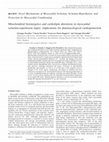
American Journal of Physiology-Heart and Circulatory Physiology, 2018
Mitochondrial dysfunction plays a central role in myocardial ischemia-reperfusion (I/R) injury. I... more Mitochondrial dysfunction plays a central role in myocardial ischemia-reperfusion (I/R) injury. Increased reactive oxygen species production, impaired electron transport chain activity, aberrant mitochondrial dynamics, Ca2+overload, and opening of the mitochondrial permeability transition pore have been proposed as major contributory factors to mitochondrial dysfunction during myocardial I/R injury. Cardiolipin (CL), a mitochondria-specific phospholipid, plays a pivotal role in multiple mitochondrial bioenergetic processes, including respiration and energy conversion, in mitochondrial morphology and dynamics as well as in several steps of the apoptotic process. Changes in CL levels, species composition, and degree of oxidation may have deleterious consequences for mitochondrial function with important implications in a variety of pathophysiological conditions, including myocardial I/R injury. In this review, we focus on the role played by CL alterations in mitochondrial dysfunction ...
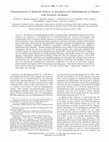
Biochemistry, Jun 20, 1998
Isovaleryl-CoA dehydrogenase (IVD) is a homotetrameric mitochondrial flavoenzyme which catalyzes ... more Isovaleryl-CoA dehydrogenase (IVD) is a homotetrameric mitochondrial flavoenzyme which catalyzes the conversion of isovaleryl-CoA to 3-methylcrotonyl-CoA. PCR of IVD genomic and complementary DNA was used to identify mutations occurring in patients with deficiencies in IVD activity. Western blotting, in vitro mitochondrial import, prokaryotic expression, and kinetic studies of IVD mutants were conducted to characterize the molecular defects caused by the amino acid replacements. Mutations leading to Arg21Pro, Asp40Asn, Ala282Val, Cys328Arg, Val342Ala, Arg363Cys, and Arg382Leu replacements were identified. Western blotting of fibroblast extracts and/or in vitro mitochondrial import experiments indicate that the seven precursor IVD mutant peptides, and a previously identified IVD Leu13Pro mutant, are synthesized and imported into mitochondria. While the IVD Leu13Pro, Arg21Pro, and Cys328Arg mutant peptides are rapidly degraded following mitochondrial import, the other mutant peptides exhibit greater mitochondrial stability, though less than the wild-type enzyme. Active IVD Ala282Val, Val342Ala, Arg363Cys, and Arg382Leu mutants were less stable than wild type when produced in Escherichia coli. The K m values of purified IVD Ala282Val, Val342Ala, and Arg382Leu mutants are 27.0, 2.8, and 6.9 µM isovaleryl-CoA, respectively, compared to 3.1 µM for the wild type, using the electron-transfer flavoprotein (ETF) fluorescence quenching assay. The catalytic efficiency per mole of FAD content of these three mutants is 4.8, 17.0, and 17.0 µM-1 •min-1 , respectively, compared to 170 µM-1 •min-1 for wild type.
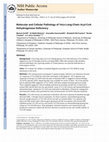
Molecular Genetics and Metabolism, May 1, 2013
Background-Very-long-chain acyl-CoA dehydrogenase (VLCAD) deficiency (VLCADD) is diagnosed in the... more Background-Very-long-chain acyl-CoA dehydrogenase (VLCAD) deficiency (VLCADD) is diagnosed in the US through newborn screening (NBS). NBS often unequivocally identifies affected individuals, but a growing number of variant patterns can represent mild disease or heterozygous carriers. Aims-To evaluate the validity of standard diagnostic procedures for VLCADD by using functional in vitro tools. Methods-We retrospectively investigated 13 patient samples referred to our laboratory because of a suspicion of VLCADD but with some uncertainty to the diagnosis. All 13 patients were suspected of having VLCADD either because of abnormal NBS or suggestive clinical findings. ACADVL genomic DNA sequencing data were available for twelve of them. Ten of the patients had an abnormal NBS suggestive of VLCADD, with three samples showing equivocal results. Three exhibited suggestive clinical findings and blood acylcarnitine profile (two of them had a normal NBS and the third one was unscreened). Assay of VLCAD activity and immunoblotting or immunohistologic staining for VLCAD were performed on fibroblasts. Prokaryotic mutagenesis and expression studies were performed for nine uncharacterized ACADVL missense mutations. Results-VLCAD activity was abnormal in fibroblast cells from 9 patients (8 identified through abnormal NBS, 1 through clinical symptoms). For these 9 patients, immunoblotting/staining showed variable presence of VLCAD; all but one had two mutated alleles. Two patients with equivocal NBS results (and a heterozygous genotype) and the two patients with normal NBS exhibited normal VLCAD activity and normal VLCAD protein on immunoblotting/staining thus ruling out VLCAD deficiency. Nine pathogenic missense mutations were characterized with prokaryotic expression studies and showed a decrease in enzyme activity and variable stability of VLCAD antigen.

Journal of Inherited Metabolic Disease, Mar 11, 2022
Very long‐chain acyl‐CoA dehydrogenase deficiency (VLCADD) is an autosomal recessive disease resu... more Very long‐chain acyl‐CoA dehydrogenase deficiency (VLCADD) is an autosomal recessive disease resulting from mutations in the ACADVL gene and is among the disorders tested for in newborn screening (NBS). Confirmatory sequencing following suspected VLCADD NBS results often identifies variants of uncertain significance (VUS) in the ACADVL gene, leading to uncertainty of diagnosis and providing effective treatment regimen. Currently, ACADVL has >300 VUSs in the ClinVar database that requiring characterization to determine potential pathogenicity. In this study, CRISPR/Cas9 genome editing was used to knock out ACADVL in HEK293T cells, and targeted deletion was confirmed by droplet digital polymerase chain reaction (PCR). No VLCAD protein was detected and an 84% decrease in enzyme activity using the electron transfer flavoprotein fluorescence reduction assay and C21‐CoA as substrate was observed compared to control. Plasmids containing control or variant ACADVL coding sequence were transfected into the ACADVL null HEK293T. While transfection of control ACADVL restored VLCAD protein and enzyme activity, cells expressing the VLCAD Val283Ala mutant had 18% VLCAD enzyme activity and reduced protein compared to control. VLCAD Ile420Leu, Gly179Arg, and Gln406Pro produced protein comparable to control but 25%, 4%, and 5% VLCAD enzyme activity, respectively. Leu540Pro and Asp570_Ala572dup had reduced VLCAD protein and 10% and 3% VLCAD enzyme activity, respectively. VLCADD fibroblasts containing the same variations had decreased VLCAD protein and activity comparable to the transfection experiments. Generating ACADVL null HEK293T cell line allowed functional studies to determine pathogenicity of ACADVL exonic variants. This approach can be applied to multiple genes for other disorders identified through NBS.
Molecular Genetics and Metabolism, Apr 1, 2022
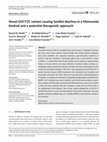
American Journal of Medical Genetics, May 5, 2021
Guanylate cyclase 2C (GC-C), encoded by the GUCY2C gene, is implicated in hereditary early onset ... more Guanylate cyclase 2C (GC-C), encoded by the GUCY2C gene, is implicated in hereditary early onset chronic diarrhea. Several families with chronic diarrhea symptoms have been identified with autosomal dominant, gain-of-function mutations in GUCY2C. We have identified a Mennonite patient with a novel GUCY2C variant (c.2381A > T; p.Asp794Val) with chronic diarrhea and an extensive maternal family history of chronic diarrhea and bowel dilatation. Functional studies including cosegregation analysis showed that all family members who were heterozygous for this variant had GI-related symptoms. HEK-293 T cells expressing the Asp794Val GC-C variant showed increased cGMP production when stimulated with Escherichia coli heat-stable enterotoxin STp (HST), which was reversed when 5-(3-Bromophenyl)-5, 11-dihydro-1,3-dimethyl-1H-indeno[2 0 ,1 0 :5,6]pyrido[2,3-d]pyrimidine-2,4,6(3H)-trione (BPIPP; a GC-C inhibitor) was used. In addition, cystic fibrosis transmembrane conductance regulator (CFTR) activity measured with SPQ fluorescence assay was increased in these cells after treatment with HST, indicating a crucial role for CFTR activity in the pathogenesis of this disorder. These results support pathogenicity of the GC-C Asp794Val variant as a cause of chronic diarrhea in this family. Furthermore, this work identifies potential candidate drug, GC-C inhibitor BPIPP, to treat diarrhea caused by this syndrome.
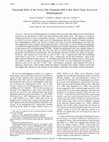
Biochemistry, 1996
The acyl-CoA dehydrogenases are a family of flavoenzymes with similar structure and function invo... more The acyl-CoA dehydrogenases are a family of flavoenzymes with similar structure and function involved in the metabolism of fatty acids and branched chain amino acids. The degree of overlap in substrate specificity is narrow among these enzymes. The position of the catalytic glutamate, identified as Glu376 in porcine medium chain acyl-CoA dehydrogenase (MCAD), Glu254 in human isovaleryl-CoA dehydrogenase (IVD), and Glu261 in human long chain acyl-CoA dehydrogenase (LCAD), has been suggested to affect substrate chain length specificity. In this study, in Vitro site-directed mutagenesis was used to investigate the effect of changing the position of the catalytic carboxylate on substrate specificity in short chain acyl-CoA dehydrogenase (SCAD). Glu368, the hypothetical active site catalytic residue of rat SCAD, was replaced with Asp, Gly, Gln, Arg, and Lys and the wild type and mutant SCADs were produced in Escherichia coli and purified. The recombinant wild type SCAD k cat /K m values for butyryl-, hexanoyl-, and octanoyl-CoA were 220, 22, and 3.2 µM-1 min-1 , respectively, while the Glu368Asp mutant gave k cat /K m of 81, 12, and 1.4 µM-1 min-1 , respectively, for the same substrates. None of the other mutants exhibited enzyme activity. A Glu368Gly/Gly247Glu double mutant enzyme, which places the catalytic residue at a position homologous to that of LCAD, was also synthesized and purified. It showed k cat /K m of 9.3, 2.8, and 1.5 µM-1 min-1 with butyryl-, hexanoyl-, and octanoyl-CoA used as substrates, respectively. These results confirm the identity of Glu368 as the catalytic residue of rat SCAD and suggest that alteration of the position of the catalytic carboxylate can modify substrate specificity.
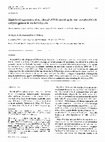
Gene, 1995
Isovaleryl-CoA dehydrogenase (IVD) catalyzes the conversion of isovaleryl-CoA to 3-methylcrotonyl... more Isovaleryl-CoA dehydrogenase (IVD) catalyzes the conversion of isovaleryl-CoA to 3-methylcrotonyl-CoA in the leucine catabolism pathway. The cDNA encoding the mature human IVD polypeptide was cloned in a prokaryotic expression vector, but the level of expression in Escherichia coli was extremely low and attempts to purify the enzyme to homogeneity were unsuccessful. To enhance expression, the nucleotide sequence of 22 codons within the l ll-bp region at the 5'-end of the cDNA was altered to accommodate E. coli codon usage without altering the amino-acid coding sequence. The altered IVD cDNA was synthesized by PCR, using a primer containing the desired modifications. Following overnight induction of the E. coli transformed with this cDNA, the enzyme was purified to homogeneity using diethylaminoethyl agarose and high-pressure ceramic hydroxyapatite resins. IVD activity was increased 165-fold in the crude extract of cells containing the modified cDNA, as compared to that containing the wild-type cDNA.
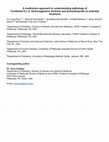
bioRxiv (Cold Spring Harbor Laboratory), Feb 3, 2023
Combined D, L-2-Hydroxyglutaric Aciduria (D,L-2HGA) is a rare genetic disorder caused by recessiv... more Combined D, L-2-Hydroxyglutaric Aciduria (D,L-2HGA) is a rare genetic disorder caused by recessive mutations in the SLC25A1 gene that encodes the mitochondrial citrate carrier protein (CIC). SLC25A1 deficiency leads to a secondary increase in mitochondrial 2-ketoglutarate that, in turn, is reduced to neurotoxic 2-hydroxyglutarate. Clinical symptoms of Combined D,L-2HGA include neonatal encephalopathy, respiratory insufficiency and often with death in infancy. No current therapies exist, although replenishing cytosolic stores by citrate supplementation to replenish cytosolic stores has been proposed. In this study, we demonstrated that patient derived fibroblasts exhibited impaired cellular bioenergetics that were worsened with citrate supplementation. We hypothesized treating patient cells with phenylbutyrate, an FDA approved pharmaceutical drug, would reduce mitochondrial 2ketoglutarate, leading to improved cellular bioenergetics including oxygen consumption and fatty acid oxidation. Metabolomic and RNA-seq analyses demonstrated a significant decrease in intracellular 2ketoglutarate, 2-hydroxyglutarate, and in levels of mRNA coding for citrate synthase and isocitrate dehydrogenase. Consistent with the known action of phenylbutyrate, detected levels of phenylacetylglutamine was consistent with the drug acting as 2-ketoglutarate sink in patient cells. Our pre-clinical studies suggest citrate supplementation is unlikely to be an effective treatment of the disorder. However, cellular bioenergetics suggests phenylbutyrate may have interventional utility for this rare disease.

Journal of Inherited Metabolic Disease, Feb 2, 2022
Inherited errors of mitochondrial fatty acid β-oxidation (FAO) are life threatening, even with op... more Inherited errors of mitochondrial fatty acid β-oxidation (FAO) are life threatening, even with optimum care. FAO is the major source of energy for heart and is critical for skeletal muscles especially during physiologic stress. Clinical trials revealed that triheptanoin (commercially known as Dojolvi; C7G), improved heart function and decreased hypoglycemia in long chain FAO disorders, but other symptoms including rhabdomyolysis persisted, suggesting suboptimal tissue distribution/utilization of heptanoic acid (C7) conjugates and/or rapid liver breakdown. In this study, medium branched chain fatty acids were tested as potential anaplerotic treatments in fibroblasts from patients deficient in very long chain acyl-CoA dehydrogenase (VLCAD), long chain 3-hydroxyacyl-CoA dehydrogenase (LCHAD), trifunctional protein (TFP), and carnitine palmitoyltransferase II (CPT II). Cells were cultured to near confluency and treated with C7, 2,6-dimethylheptanoic acid (dMC7), 6-amino-2,4-dimethylheptanoic acid (AdMC7), or 4,8-dimethylnonanoic acid (dMC9) for 72 h and targeted metabolomics performed. The profile of TCA cycle intermediates was improved in cells treated with these branched chain fatty acids compared with C7. Intracellular propionate was higher in AdMC7 treated cells compared with C7 in VLCAD, LCHAD, and TFP deficient cell lines. With AdMC7 treatment, succinate was higher in CPT II and VLCAD deficient cells, compared with C7. Malate and glutamate were consistently higher in AdMC7 treated VLCAD, LCHAD, TFP, and CPT II deficient cells compared with the C7 treatment. The results provide the impetus to further evaluate and consider branched chain fatty acids as viable anaplerotic therapy for fatty acid oxidation disorders and other diseases.
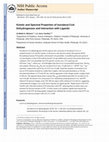
Biochimie, 2015
Isovaleryl-CoA dehydrogenase (IVD) catalyzes the conversion of isovaleryl-CoA to 3methylcrotonyl-... more Isovaleryl-CoA dehydrogenase (IVD) catalyzes the conversion of isovaleryl-CoA to 3methylcrotonyl-CoA and the transfer of electrons to the electron transfer flavoprotein (ETF). Recombinant human IVD purifies with bound CoA-persulfide. A modified purification protocol was developed to isolate IVD without bound CoA-persulfide and to protect the protein thiols from oxidation. The CoA-persulfide-free IVD specific activity was 112.5 µmol porcine ETF•min −1 •mg −1 , which was ~20-fold higher than that of its CoA-persulfide bound form. The K m and catalytic efficiency (k cat /K m) for isovaleryl-CoA were 1.0 µM and 4.3 × 10 6 •M −1 •sec −1 per monomer, respectively, and its K m for ETF was 2.0 µM. Anaerobic titration of isovaleryl-CoA into an IVD solution resulted in a stable blue complex with increased absorbance at 310 nm, decreased absorbance at 373 and 447 nm, and the appearance of the charge transfer complex band at 584 nm. The apparent dissociation constant (K D app) determined spectrally for isovaleryl-CoA was 0.54 µM. Isovaleryl-CoA, acetoacetyl-CoA, methylenecyclopropylacetyl-CoA, and ETF induced CD spectral changes at the 250-500 nm region while isobutyryl-CoA did not, suggesting conformational changes occur at the flavin ring that are ligand specific. Replacement of the IVD Trp166 with a Phe did not block IVD interaction with ETF, indicating that its indole ring is not essential for electron transfer to ETF. A twelve amino acid synthetic peptide that matches the sequence of the ETF docking peptide competitively inhibited the enzyme reaction when ETF was used as the electron acceptor with a K i of 1.5 mM. Keywords acyl-CoA dehydrogenase; electron-transferring flavoprotein Isovaleryl-CoA dehydrogenase (IVD; 1 EC 1.3.99.10) is an intramitochondrial homotetrameric flavoenzyme in the leucine catabolism pathway that catalyzes the α,β
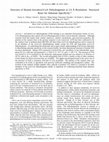
Biochemistry, Jul 1, 1997
Isovaleryl-CoA dehydrogenase (IVD) belongs to an important flavoprotein family of acyl-CoA dehydr... more Isovaleryl-CoA dehydrogenase (IVD) belongs to an important flavoprotein family of acyl-CoA dehydrogenases that catalyze the R,-dehydrogenation of their various thioester substrates. Although enzymes from this family share similar sequences, catalytic mechanisms, and structural properties, the position of the catalytic base in the primary sequence is not conserved. E376 has been confirmed to be the catalytic base in medium-chain (MCAD) and short-chain acyl-CoA dehydrogenases and is conserved in all members of the acyl-CoA dehydrogenase family except for IVD and long-chain acyl-CoA dehydrogenase. To understand this dichotomy and to gain a better understanding of the factors important in determining substrate specificity in this enzyme family, the three-dimensional structure of human IVD has been determined. Human IVD expressed in Escherichia coli crystallizes in the orthorhombic space group P2 1 2 1 2 1 with unit cell parameters a) 94.0 Å, b) 97.7 Å, and c) 181.7 Å. The structure of IVD was solved at 2.6 Å resolution by the molecular replacement method and was refined to an R-factor of 20.7% with an R free of 28.8%. The overall polypeptide fold of IVD is similar to that of other members of this family for which structural data are available. The tightly bound ligand found in the active site of the structure of IVD is consistent with that of CoA persulfide. The identity of the catalytic base was confirmed to be E254, in agreement with previous molecular modeling and mutagenesis studies. The location of the catalytic residue together with a glycine at position 374, which is a tyrosine in all other members of the acyl-CoA dehydrogenase family, is important for conferring branched-chain substrate specificity to IVD.
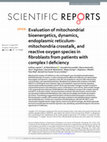
Scientific Reports, Jan 18, 2018
Mitochondrial complex I (CI) deficiency is the most frequent cause of oxidative phosphorylation (... more Mitochondrial complex I (CI) deficiency is the most frequent cause of oxidative phosphorylation (OXPHOS) disorders in humans. In order to benchmark the effects of CI deficiency on mitochondrial bioenergetics and dynamics, respiratory chain (RC) and endoplasmic reticulum (ER)-mitochondria communication, and superoxide production, fibroblasts from patients with mutations in the ND6, NDUFV1 or ACAD9 genes were analyzed. Fatty acid metabolism, basal and maximal respiration, mitochondrial membrane potential, and ATP levels were decreased. Changes in proteins involved in mitochondrial dynamics were detected in various combinations in each cell line, while variable changes in RC components were observed. ACAD9 deficient cells exhibited an increase in RC complex subunits and DDIT3, an ER stress marker. The level of proteins involved in ER-mitochondria communication was decreased in ND6 and ACAD9 deficient cells. |ΔΨ| and cell viability were further decreased in all cell lines. These findings suggest that disruption of mitochondrial bioenergetics and dynamics, ER-mitochondria crosstalk, and increased superoxide contribute to the pathophysiology in patients with ACAD9 deficiency. Furthermore, treatment of ACAD9 deficient cells with JP4-039, a novel mitochondria-targeted reactive oxygen species, electron and radical scavenger, decreased superoxide level and increased basal and maximal respiratory rate, identifying a potential therapeutic intervention opportunity in CI deficiency. Complex I (CI), the largest component of the electron transport chain, is the major entry point of electrons into oxidative phosphorylation (OXPHOS), and catalyzes the transfer of two electrons from NADH + to ubiquinone, thus contributing to the establishment of the proton gradient required for ATP synthesis. It contains 45 subunits forming an "L-shaped" structure with an inner mitochondrial membrane arm and a matrix arm. Fourteen
Molecular Genetics and Metabolism, Mar 1, 2023
Molecular Genetics and Metabolism, Mar 1, 2023










Uploads
Papers by Al-Walid Mohsen